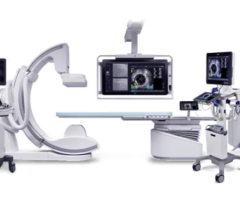
September 19, 2016 — Shockwave Medical announced positive clinical results from the pooled DISRUPT PAD Study, a single-arm, two-phase, multicenter study evaluating the safety and performance of company’s Lithoplasty System. The technology fuses an angioplasty balloon with a series of small lithotripsy emitters that use ultrasonic pulses to shatter the calcium.
Results from 95 patients with symptomatic femoropopliteal lesions up to 15 cm in length enrolled at 11 sites were presented at the VIVA 2016 meeting in Las Vegas by principal investigator Thomas Zeller, M.D., head of the Department of Angiology at Universitäts-Herzzentrum Freiburg-Bad, Krozingen, Germany.
The DISRUPT PAD Study primary safety endpoint was freedom from major adverse events (MAE) through 30 days. Procedural success, the primary performance endpoint, was defined as less than 50 percent residual diameter stenosis, with or without adjunctive balloon angioplasty therapy. Key secondary endpoints include target lesion revascularization, target lesion patency by duplex ultrasound defined as freedom from greater than 50 percent restenosis, and functional outcomes.
Watch a video animation of the Lithoplasty System.
“The ongoing positive results from DISRUPT PAD demonstrate that Lithoplasty technology is a promising treatment for patients with calcified peripheral artery disease, a difficult-to-treat population,” said Prof. Zeller. “After six months of follow-up, we have documented consistent and predictable procedural success, high acute gain, minimal vessel injury, and remarkably low need for additional implants.”
Clinical data from the study demonstrate compelling safety with no major amputations, perforations, thrombus or distal embolization events. Stent utilization due to a flow limiting dissection following Lithoplasty was limited to 1 percent in study population composed of moderate or severely calcified lesions. Primary effectiveness results demonstrated 100 percent procedural success defined as residual stenosis of less than 50 percent. An exploratory endpoint of procedural success defined as residual stenosis of less than 30 percent was achieved in 89.5 percent of lesions, with an average residual stenosis of 24 percent and acute gain of 3 mm (average RVD of 5.5 mm). Six-month patency assessed by duplex ultrasound was 77 percent with target lesion revascularization of 3.2 percent.
Arterial calcification, caused by plaque that hardens over time, is increasingly common as preventive care and disease management have enabled patients to live longer, making vascular disease a chronic condition. In fact, over half of all patients with peripheral vascular disease have moderate or severe calcium in their arteries.1 Unfortunately, limitations of currently available interventional devices make successful treatment of patients with calcified arteries increasingly more difficult. The most advanced of these devices targets only superficial calcium, leaving deep calcium unaffected, frequently resulting in poor lesion dilatation and procedural complications. Designed to overcome these limitations, Lithoplasty is a novel technology that uses pulsatile mechanical energy waves to disrupt both superficial and deep calcium while minimizing soft tissue injury using an integrated balloon to dilate lesions at low pressures to restore blood flow.
The Shockwave Medical Lithoplasty System is available for sale in the United States as of September 2016. The company plans a limited U.S. commercial release in 2017 and will initiate a global randomized trial to gather further clinical data on the benefits of Lithoplasty treatment.
"The DISRUPT PAD data continue to reinforce the potential of the Lithoplasty System to address the growing burdens of arterial calcification,” said Shockwave Medical CEO and co-founder Daniel Hawkins. “This data prepares us to further advance use of the technology for patients with peripheral disease as we embark on commercialization in the United States.”
“We are very pleased with the durable success the Lithoplasty System has demonstrated in treating calcified peripheral artery disease,” said Todd Brinton, M.D., clinical associate professor of medicine at Stanford and co-founder of Shockwave Medical. "We will continue to expand our global clinical program and look forward to working with physicians to further address the needs of patients with advanced cardiovascular disease."
Read the article “FDA Clears Lithoplasty Balloon That Shatters Calcified Lesions With Ultrasound.”
Watch the VIDEO “Breaking Up Calcified Lesions Without Vessel Trauma.” A discussion with Todd Brinton, M.D., at TCT 2016 about the newly FDA-cleared Shockwave Medical Lithoplasty System. Brinton is clinical associate professor and adjunct associate professor of bioengineering at Stanford University Medical Center.
For more information: www.shockwavemedical.com


 December 20, 2023
December 20, 2023 








